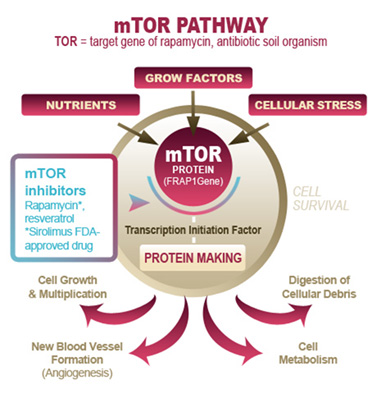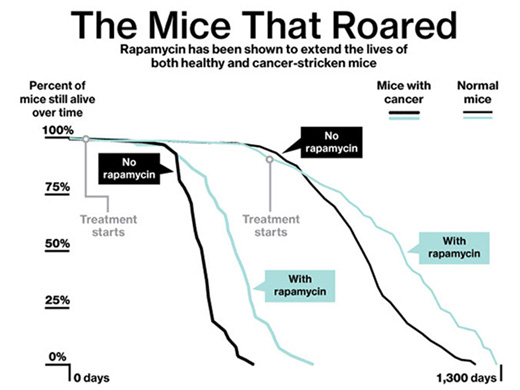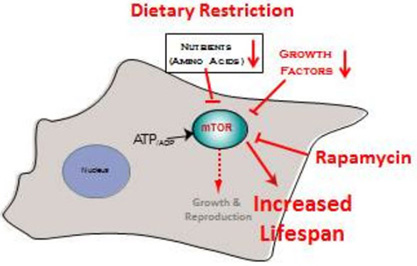
mTOR inhibitors in cancer, health and aging
November 27th, 2016mTOR inhibitors in cancer, health and aging
By Marios Kyriazis, M.D.
When it comes to regulating aging, an important molecule which has widespread effects is mTOR. mTOR is the acronym for the Mechanistic (previously also called ‘mammalian’) Target of Rapamycin. Rapamycin (also known as sirolimus) is a protein kinase anti-fungal agent that was first discovered in the soils of Easter Island in the 1970s, which has been found to regulate the proliferation and development of cells, and to act as an immunosuppressant. It has been used to dampen the immune response following transplants. Rapamycin also has a positive effect on the heart and brain, particularly in age-related neurodegenerative diseases.
mTOR acts as a central controller in signalling pathways which regulate the survival and function of the cell. It can affect cell division processes, the response to stress, and general cell and protein tasks. These signalling pathways are very complicated and depend on many feedback loops, energy supply, and a great variety of other molecules or signals. During certain diseases and aging, the function of mTOR can become deregulated and result in clinical manifestations, [see figure 1]. Despite talking about mTOR as if it is just one molecule, it functions, in fact, as two separate complexes called mTORC1 and mTORC2. (1)

Figure 1: The impact of mTOR on various aspects of aging.
Several compounds have now been developed (or discovered) which inhibit some of the actions of mTOR and so improve certain health parameters. Rapamycin and its analogues inhibit the immune response by blocking the proliferation of T-cells and by reducing the impact of interleukin inflammatory compounds. They also block the formation of new blood vessels (angiogenesis) which results in cancer cells being deprived of their blood supply.
Other mTOR inhibitors have been developed, but most of these are based on the basic rapamycin molecular structure. For example, the rapamycin derivative temsirolimus is a soluble agent which has a reduced risk of side effects compared to rapamycin. Since it is water soluble, it can be administered by intravenous infusion. It is approved by the FDA for the treatment of kidney tumours.
Other derivative molecules (called rapalogs, i.e. ‘rapamycin analogues’) are:
- Everolimus (approved initially for the treatment of kidney tumours, and more recently for the treatment of breast and pancreatic tumours).
- Ridaforolimus (also known as Deforolimus) is used for breast and other cancers.
These drugs bind to the same sites as rapamycin, and are considered to be generally better inhibitors. They can be used orally, as well as by intravenous injection. They work by stopping the growth of some cancers, but are not very effective in all cancers, particularly if used alone. One important mechanism of action of these rapalogs is through competition for the ATP molecule, thus blocking energy supply to tumour cells. Many rapalogs also interfere with apoptosis (loss of damaged cells). This results in increased apoptosis of cancer cells, thereby reducing the size of the tumour. These drugs inhibit both mTORC1 and mTORC2 elements, [see figure 2].

Figure 2: Metformin, rapamycin and some other compounds with mTOR and insulin/IGF-1-like signalling (IIS)-inhibitory potential (resveratrol, melatonin, etc.) are able to modify both aging and carcinogenesis. Anisimov VN. Metformin and rapamycin are master-keys for understanding the relationship between cell senescent, aging and cancer. AGING, Vol 5, No 5 , pp 337-338.
Although initially promising, these rapalogs may be more effective if used in association with other tumour-suppressing agents. However, it remains unclear as to what specific tumours to use these agents on, because it all depends on what markers each tumour carries and how sensitive these markers are. Nevertheless, research is continuing at a quick pace.
Apart from synthetic inhibitors of mTOR, there are certain natural ones. The following are some examples which are also used for their antiaging benefits and effects.
- Epigallocatechin gallate:
Also known as EGCG, this is a well-known natural compound (a component of green tea), with multiple benefits. It can disrupt the mTOR pathway and is effective in inducing apoptosis of human pancreatic cells in the laboratory.(2) The researchers stated: “Our results revealed that EGCG dramatically inhibited the proliferation of (pancreatic cancer) cells and induced apoptosis simultaneously. Furthermore, it upregulated (improved) mRNA and protein expression levels, as well as downregulated the expression of phospho-AKT and phospho-mTOR”.
- Caffeine:
Caffeine can induce apoptosis of cancer cells through modulation of the p53 element which takes active part in apoptosis. Caffeine can also induce autophagy. This can be achieved through inhibition of the mTOR pathway, so a possible benefit associated with this is an anti-cancer activity.(3) In this regard, caffeine can be used in addition to chemotherapy in bone and soft tissue tumours. Caffeine affects mTOR and other protein kinases, and reduces inflammation markers.(4)
- Curcumin:
This ingredient of turmeric can be used with other established chemotherapy drugs in order to enhance their action, particularly in difficult-to-treat tumours such as glioblastoma in the brain. The mechanism is rooted in the ability of curcumin to block the mTOR pathway and thus enhance apoptosis of cancerous cells. (5) Curcumin down-regulates the mTOR signalling pathway, reduces the accumulation of beta-amyloid (the aggregate found in Alzheimer’s dementia) and thus improves cognitive function in mice. This effect is also due to the curcumin’s ability to induce autophagy, i.e. degradation of abnormal protein accumulation. It can therefore be used as a neuroprotective agent during aging. (6)
- Resveratrol:
The case of resveratrol is particularly interesting. Resveratrol can inhibit certain cancers, and recent research has confirmed that one of the mechanisms involved is mTOR inhibition, as well as modulation of apoptosis. The same mechanism may underlie resveratrol’s antiaging effects. (9) Resveratrol and rapamycin can enhance each other’s actions. At a very high dose, resveratrol can suppress aging through its mTOR inhibition mechanism alone. It is well known that apart from its effects on cancer, mTOR also has several effects on the aging process. (10) This may explain resveratrol’s multiple actions and benefits.
- Other phytochemicals:
All of the following have been found to inhibit the mTOR pathway: (7) timosaponin; genistein; diosgenin; gallic acid; and pomegranate. In a review paper published in 2011, it was reported that these compounds, though an inhibition of the mTOR pathway, enhance reprogramming of pluripotent stem cells. This shows that there are common pathways in cell regulation which can be affected by modulation of mTOR and can eventually affect aging itself. (8)
Several experiments in mice and other animals have shown that the mTOR molecule can affect both the average and maximum lifespan. (11) [See figure 3].
 Figure 3: Gifford, B. Did a Canadian medical expedition lead to the discovery of an antiaging pill? Bloomberg News, February 12, 2015.
Figure 3: Gifford, B. Did a Canadian medical expedition lead to the discovery of an antiaging pill? Bloomberg News, February 12, 2015.
As mentioned above, agents such as rapamycin work by improving signalling between the cells. An example of these pathways is the regulation of the Growth Hormone/insulin/IGF-1 pathway, inactivation of which has been shown to increase lifespan in the laboratory. (12) In a systematic review of the top 10 antiaging interventions being studied today, mTOR interventions were classed second in importance, with calorie restriction being first, and nutrients such as resveratrol being third. (13) [See figure 4].

Figure 4: How rapamycin can mimic the effects of dietary restriction. Research explains action of drug that may slow aging and related disease. OSU News & Research Communications 20 May 2014
Oxaloacetate – a most promising compound
Oxaloacetate is an organic compound which takes part in several metabolic processes such as synthesis of amino acids and fatty acids; it also regulates mitochondrial and brain function. Among its other benefits, it is an antioxidant, brain function-enhancer, and a modulator of certain age-related genes such as FOXO. Plus, oxaloacetate is also an effective mTOR modulator.
In fact, oxaloacetate may also be considered to be an mTOR mimetic, which means that it has benefits similar to other mTOR inhibitors (such as modulation of apoptosis and reduction of glutamate). However, it has additional benefits that originate from mechanisms other than mTOR inhibition. (14)
Oxaloacetate is a well-known calorie restriction mimetic, and can even be considered as an exercise-mimetic [Ed. – we have asked Dr. Kyriazis to write about exercise mimetics for a future issue of the Aging Matters™ magazine]. This is because it can help increase production of energy and improve muscle endurance.
Supplementation with oxaloacetate increases lifespan in C. elegans worms. This is dependent on the transcription factor FOXO, as mentioned above, but also on protein kinases which depend on adenosine monophosphate (AMP)–which is involved in energy production. (15) Perhaps an interesting situation here is to realize that mechanisms for aging regulation, energy production and mTOR regulation are all interdependent, and one compound may have multiple effects across many regulatory pathways. Carnosine was another good example of this–but now research supports oxaloacetate as another pluripotent agent.
Summary
It is clear that aging is very dependent upon mTOR-regulated pathways and processes, and that several agents acting on these pathways have direct or indirect benefits. Several pathways involved in cancer can be regulated by mTOR inhibitors, and many of these pathways are also involved in aging. It is logical to assume that mTOR inhibitors have a positive benefit on aging.
Some antiaging physicians and scientists are recommending the more natural molecules involved in mTOR inhibition (such as resveratrol, oxaloacetate or curcumin) be added to our anti-aging regimens as a way of addressing age-related health problems.
 The impact of mTORC1 on the diseases of aging. Johnson SC, Rabinovitch PS, & Kaeberlein M. mTOR is a key modulator of aging and age-related disease. Nature (17 January 2013), 493,338–345
The impact of mTORC1 on the diseases of aging. Johnson SC, Rabinovitch PS, & Kaeberlein M. mTOR is a key modulator of aging and age-related disease. Nature (17 January 2013), 493,338–345
References
- Zhou H et al. Updates of mTOR inhibitors. Anticancer Agents Med Chem. 2010 Sep;10(7):571-81
- Liu S et al. PI3K/AKT/mTOR signaling is involved in (-)-epigallocatechin-3-gallate-induced apoptosis of human pancreatic carcinoma cells. Am J Chin Med. 2013;41(3):629-42
- Saiki S et al. Caffeine induces apoptosis by enhancement of autophagy via PI3K/Akt/mTOR/p70S6K inhibition. Autophagy. 2011 Feb;7(2):176-87
- Miwa S et al. Caffeine induces apoptosis of osteosarcoma cells by inhibiting AKT/mTOR/S6K, NF-κB and MAPK pathways. Anticancer Res. 2012 Sep;32(9):3643-9
- Yin H et al. Curcumin sensitizes glioblastoma to temozolomide by simultaneously generating ROS and disrupting AKT/mTOR signaling. Oncol Rep. 2014 Oct;32(4):1610-6
- Wang C et al. Downregulation of PI3K/Akt/mTOR signaling pathway in curcumin-induced autophagy in APP/PS1 double transgenic mice. Eur J Pharmacol. 2014 Oct 5;740:312-20
- Tan HK et al. The mTOR signalling pathway in cancer and the potential mTOR inhibitory activities of natural phytochemicals. Asian Pac J Cancer Prev. 2014;15(16):6463-75
- Chen T et al. Rapamycin and other longevity-promoting compounds enhance the generation of mouse induced pluripotent stem cells. Aging Cell. 2011 Oct;10(5):908-11
- Sui T et al. Resveratrol inhibits the phosphatidylinositide 3-kinase/protein kinase B/mammalian target of rapamycin signaling pathway in the human chronic myeloid leukemia K562 cell line. Oncol Lett. 2014 Jun;7(6):2093-2098
- Johnson SC et al. Modulating mTOR in Aging and Health. Interdiscip Top Gerontol. 2015;40:107-27
- Lamming DW et al. Rapalogs and mTOR inhibitors as anti-aging therapeutics. J Clin Invest. 2013 Mar 1;123(3):980-9
- Anisimov VN. Conservative Growth Hormone/IGF-1 and mTOR Signaling Pathways as a Target for Aging and Cancer Prevention: Do We Really Have an Antiaging Drug? Interdiscip Top Gerontol. 2015;40:177-88
- Allison DB et al. Aging and energetics’ ‘Top 40’ future research opportunities 2010-2013 [v1; ref status: indexed, http://f1000r.es/4ae] F1000Research 2014, 3:219 (doi: 10.12688/f1000research.5212.1)
- Wilkins et al. Oxaloacetate activates brain mitochondrial biogenesis, enhances the insulin pathway, reduces inflammation and stimulates neurogenesis. Hum Mol Genet. 2014 Dec 15;23(24):6528-41.
- Williams DS et al. Oxaloacetate supplementation increases lifespan in Caenorhabditis elegans through an AMPK/FOXO-dependent pathway. Aging Cell. 2009 December; 8(6): 765–768.








